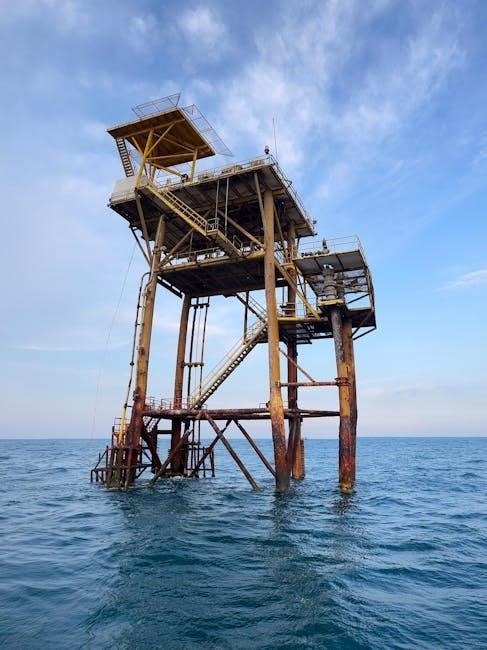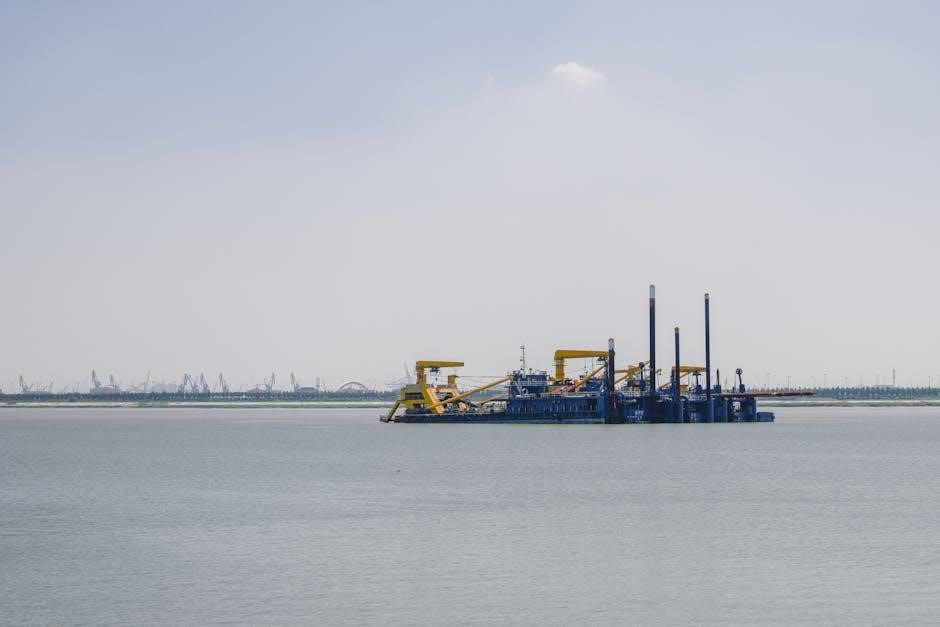homemade water well drilling rig plans pdf
A homemade water well drilling rig offers a cost-effective and self-reliant solution for accessing groundwater. This setup allows individuals to drill wells independently, promoting water security and reducing reliance on external services.
1.1 What is a Homemade Water Well Drilling Rig?
A homemade water well drilling rig is a DIY setup designed to drill wells for accessing groundwater. It typically consists of a sturdy frame, a drilling mechanism, and a power source, such as a motor or engine. These rigs are often built using readily available materials like steel pipes, PVC, and recycled components, making them cost-effective. The rig operates by rotating a drill bit attached to a shaft, which bores into the ground to reach water-bearing rock or soil layers. While homemade rigs may lack the efficiency of professional equipment, they offer a practical solution for individuals seeking water independence, especially in rural or off-grid areas. The design can be customized to suit specific needs, such as shallow or deep wells, and can be powered manually or mechanically. This approach empowers users to manage water resources sustainably and affordably, though it requires careful planning and execution to ensure safety and effectiveness.
1.2 Why Consider a DIY Approach for Water Well Drilling?
Considering a DIY approach for water well drilling offers numerous advantages, particularly for individuals seeking cost-effective and self-reliant solutions. Considerably, professional drilling services can be expensive, making DIY rigs an attractive alternative for those on a budget. Additionally, building your own rig empowers you to take control of your water supply, fostering independence and self-sufficiency. This method is especially beneficial for remote or rural areas where access to professional services may be limited or costly. Furthermore, a DIY rig allows for customization to suit specific needs, such as shallow wells or small-scale projects. It also provides an opportunity to learn valuable skills in engineering and problem-solving. While the process may require time and effort, the long-term benefits of having a reliable water source make it a worthwhile investment. Overall, a DIY water well drilling rig is a practical and empowering solution for those looking to manage their water resources sustainably and affordably.
Importance and Benefits of Homemade Water Well Drilling Rigs
Homemade water well drilling rigs provide cost savings, environmental benefits, and empowerment through self-sufficiency. They enable individuals to access water independently, reducing reliance on external services and promoting sustainable water management.

2.1 Cost Savings Compared to Professional Services
Building a homemade water well drilling rig significantly reduces costs compared to hiring professional services. Professional drilling can be expensive, with prices escalating based on depth and complexity. By taking the DIY approach, individuals can save thousands of dollars in labor costs alone. Additionally, sourcing materials locally or repurposing existing equipment further lowers expenses. The DIY method also eliminates the need for ongoing service contracts, allowing for long-term financial savings. Moreover, the ability to perform maintenance and repairs independently reduces reliance on external technicians. This cost-effectiveness makes homemade rigs an attractive option for those seeking to access water without hefty financial burdens. The savings can then be reinvested into other projects or used to enhance the rig’s functionality over time. Overall, the financial benefits of a homemade rig are substantial, making it a practical choice for budget-conscious individuals and families.
2.2 Environmental Benefits of Self-Reliance
Building and operating a homemade water well drilling rig offers several environmental benefits. By relying on self-reliance, individuals reduce the need for large-scale industrial drilling operations, which often have higher carbon footprints. DIY rigs typically use smaller, more efficient equipment, minimizing energy consumption and emissions. Additionally, homemade rigs can be powered using renewable energy sources like solar or wind, further reducing their environmental impact. The ability to drill on a smaller scale also allows for more precise water extraction, reducing waste and preserving groundwater resources. Furthermore, homemade rigs encourage the use of locally sourced and recycled materials, minimizing transportation emissions and supporting sustainable practices. By adopting this approach, individuals contribute to a reduction in industrial drilling’s ecological footprint while maintaining control over their water supply. This self-sufficient method aligns with eco-conscious values and promotes a more sustainable way of accessing water.
2.3 Empowerment Through Self-Sufficiency
Building a homemade water well drilling rig empowers individuals by fostering self-sufficiency and independence. By taking control of water extraction, people gain the ability to meet their own needs without relying on external services. This self-reliance builds confidence and a sense of accomplishment, as individuals overcome challenges and acquire new skills. The process of designing and constructing the rig also enhances problem-solving abilities and mechanical knowledge. Self-sufficiency extends beyond water access, as the skills and mindset gained can be applied to other projects and areas of life. Additionally, this empowerment strengthens community resilience, as individuals can share knowledge and resources, inspiring others to adopt similar practices. By reducing dependence on external systems, homemade water well drilling rigs promote a sense of autonomy and preparedness, enabling people to thrive even in remote or resource-limited environments.
Materials and Tools Needed for the Project
Constructing a homemade water well drilling rig requires essential materials like steel pipes, drill bits, and a motor. Tools such as wrenches, drills, and welding equipment are also necessary for assembly and operation.

3.1 Essential Materials for the Drilling Rig
The foundation of a homemade water well drilling rig begins with selecting the right materials. Steel pipes are crucial for the drill stem and casing, ensuring durability and strength. High-carbon steel drill bits are necessary for penetrating various soil types. A robust electric or gasoline-powered motor provides the required torque for drilling. Additionally, a sturdy frame, typically made from steel or iron, is needed to support the rig’s structure. Pulleys and belts are essential for transmitting power from the motor to the drill bit. Proper fasteners like bolts and nuts ensure all components are securely attached. Lastly, a water supply system, including hoses and pumps, is vital for cooling the drill bit and removing debris during operation. These materials must be sourced from reliable suppliers to ensure quality and longevity of the rig.
3.2 Tools Required for Assembly and Operation
Constructing and operating a homemade water well drilling rig demands a variety of tools to ensure efficiency and safety. For assembly, essential tools include wrenches, screwdrivers, and drills for securing bolts and nuts. A saw or cutting torch is necessary for modifying steel pipes to the required lengths. Pliers and hammers are handy for adjusting and fitting components. During operation, a drill bit set, including spade and tricone bits, is vital for penetrating different soil layers. A pressure gauge helps monitor drilling force, while a water pump ensures consistent coolant flow. Safety tools like gloves, goggles, and a first-aid kit are indispensable. Additionally, a multimeter and wire cutters are useful for troubleshooting electrical connections. Proper organization and maintenance of these tools are crucial for the rig’s smooth operation and longevity. Having the right tools on hand ensures the project progresses efficiently and safely.
3.3 Where to Source Affordable Materials
Acquiring affordable materials for your homemade water well drilling rig is crucial to keep costs low. Local hardware stores, home improvement centers, and online retailers often carry essential components like steel pipes, drill bits, and motors at competitive prices. Salvage yards and second-hand markets can be excellent sources for used or surplus materials, such as pumps or gears, which can be refurbished for your project. Additionally, online platforms like eBay, Craigslist, or Facebook Marketplace frequently list affordable tools and parts from private sellers. For specialized items, consider reaching out to local farmers or contractors who may have unused equipment. Always compare prices and negotiate when possible to maximize savings. Sourcing materials strategically ensures your project remains budget-friendly while maintaining quality and functionality.

Step-by-Step Instructions for Building the Rig
Constructing a homemade water well drilling rig involves detailed planning and precise execution. Follow a structured guide to assemble components, ensuring stability and functionality for safe and effective groundwater extraction.
4.1 Planning and Designing the Drilling Rig
Planning and designing a homemade water well drilling rig is the foundation of a successful project. Begin by assessing your drilling site and determining the intended use of the well. Research local water tables and soil conditions to estimate drilling depth and required equipment. Sketch a detailed blueprint, considering the rig’s stability, portability, and ease of operation. Decide on the drilling method—whether cable tool, rotary, or percussion—based on your resources and expertise. Select appropriate materials for the frame, drill pipe, and power source, ensuring durability and safety. Create a parts list and gather tools for assembly. Incorporate safety features, such as emergency stops and secure fastening systems, into your design. Finally, review local regulations and environmental guidelines to ensure compliance. A well-planned design ensures efficiency, safety, and long-term functionality of your homemade drilling rig.
4.2 Assembling the Basic Structure of the Rig
Assembling the basic structure of the homemade water well drilling rig begins with constructing a sturdy base frame. Use durable materials like steel beams or heavy-duty wood to ensure stability. Secure the frame to the ground using anchors or weights to prevent movement during drilling. Next, attach the mast or tower, which will support the drilling mechanism. Ensure the mast is vertically aligned and firmly bolted to the base. Install the motor and gearbox, aligning them precisely with the drill pipe. Mount the drill pipe and bit holder, making sure they are securely fastened. Add supports or braces to reinforce the structure and prevent wobbling. Finally, connect all components tightly and test the rig’s stability before proceeding. Proper assembly ensures safety and efficiency during the drilling process.

4.3 Installing the Drilling Mechanism
Installing the drilling mechanism is a critical step in building a functional homemade water well drilling rig. Begin by attaching the drill pipe to the mast, ensuring it is aligned with the motor and gearbox. Secure the drill bit holder to the end of the pipe, making sure it is tightly fastened. Next, connect the motor to the gearbox, ensuring proper gear alignment for smooth operation. Mount the motor and gearbox assembly to the mast, using bolts or welding for a sturdy connection. Install the pulley system or chain drive to transmit power from the motor to the drill pipe. Ensure all moving parts are well-lubricated and properly aligned to minimize wear and tear. Finally, test the mechanism by running it at a low speed to check for any vibrations or misalignments. Proper installation of the drilling mechanism is essential for efficient and safe drilling operations.
4.4 Adding Safety Features and Controls
Adding safety features and controls is essential to ensure the safe operation of your homemade water well drilling rig. Begin by installing an emergency stop button or lever, which can immediately halt the drilling mechanism in case of an accident. Secure all moving parts, such as gears and pulleys, with protective guards to prevent accidental contact. Ensure the rig is stabilized with anchor points or weights to prevent tipping during operation. Install a control panel with clear labels for all functions, including speed adjustment and directional controls. Consider adding pressure sensors to monitor drilling force and prevent overloading. Finally, incorporate an emergency shutdown mechanism that automatically engages if critical systems fail. Always test these safety features before operation and ensure they function reliably. Regular inspections and maintenance of these controls are crucial for long-term safety and efficiency.

Safety Precautions and Best Practices
Adhering to safety precautions is crucial when building and operating a homemade water well drilling rig. Always wear protective gear, follow proper handling techniques, and ensure the rig is stable and secure before use.
5.1 General Safety Guidelines for DIY Projects
When embarking on a DIY project like building a homemade water well drilling rig, it is essential to follow general safety guidelines to minimize risks. First, always wear appropriate protective gear, including safety glasses, gloves, and a hard hat, to protect yourself from potential hazards. Ensure the workspace is well-ventilated and free from flammable materials. Properly secure all tools and equipment to prevent accidental movement or collapse. Familiarize yourself with the operation of all machinery and tools before use, and never operate equipment when fatigued or under the influence of substances that impair judgment. Keep a first aid kit nearby and have a plan for emergency situations. Regularly inspect equipment for wear and tear, and address any issues promptly. By adhering to these guidelines, you can create a safer environment for yourself and others involved in the project.
5.2 Handling Tools and Equipment Safely
Handling tools and equipment safely is crucial when working on a homemade water well drilling rig. Always inspect tools before use to ensure they are in good condition and free from damage. Use the correct tool for the task to avoid accidents and prevent damage to the equipment. When operating power tools or machinery, maintain a firm grip and keep loose clothing or long hair tied back to avoid entanglement. Store tools and equipment in a dry, secure location to prevent rust or unauthorized use. Regularly lubricate moving parts to ensure smooth operation and reduce wear. Never leave running equipment unattended, and always follow the manufacturer’s instructions for operation and maintenance. Properly train anyone assisting with the project to handle tools safely. Supervise inexperienced users closely and ensure all safety precautions are followed. By prioritizing safe handling practices, you can minimize risks and ensure a successful project.
5.3 Environmental Considerations During Drilling
When constructing and operating a homemade water well drilling rig, it’s essential to consider the environmental impact of your project. Proper disposal of drilling byproducts, such as mud and cuttings, is critical to prevent soil and water contamination. Always use eco-friendly drilling fluids and avoid toxic chemicals that could seep into the groundwater. Minimize water usage by recycling drilling water whenever possible and ensuring efficient operation of the rig. Avoid drilling in ecologically sensitive areas, such as wetlands or habitats of endangered species, to preserve biodiversity. Noise reduction measures, like mufflers or sound barriers, can help protect wildlife and neighboring communities. After completing the well, restore the drilling site by filling any unused boreholes and replanting vegetation. By adhering to these practices, you can help protect the environment while successfully completing your water well project. Remember, responsible drilling ensures a sustainable water source for future generations.

Troubleshooting Common Issues
Troubleshooting is crucial for maintaining efficiency and safety in homemade water well drilling. Identifying and addressing mechanical failures, drilling difficulties, and operational problems ensures the rig functions optimally and prolongs its lifespan effectively.

6.1 Identifying and Solving Common Problems
When operating a homemade water well drilling rig, common issues like mechanical failures, bit wear, and water flow problems often arise. Identifying these problems early is key to preventing costly repairs and ensuring continuous operation. Start by inspecting the rig’s components regularly, paying attention to unusual noises, vibrations, or leaks. If the drill bit becomes dull or clogged, replace or clean it promptly to maintain drilling efficiency. Water flow issues may indicate a blockage in the piping system or insufficient water supply, which can be resolved by clearing the pipes or adjusting the pump. Additionally, electrical or hydraulic system malfunctions should be addressed by checking connections and fluid levels. Keeping a troubleshooting checklist handy can help diagnose and solve problems quickly, minimizing downtime and extending the rig’s lifespan. Regular maintenance and timely repairs are essential for optimal performance and safety.
6.2 Dealing with Drilling Difficulties
Drilling difficulties, such as hard soil, rock layers, or machinery malfunctions, are common challenges when using a homemade water well drilling rig. To address these issues, start by assessing the problem thoroughly; If the drill bit encounters hard soil or rock, consider switching to a more durable bit or applying additional downward pressure. Lubricating the drill shaft or using a mud rotary system can also help reduce friction and improve progress. If the rig stalls or overheats, check for worn parts, tighten loose connections, and ensure proper lubrication. Water flow issues may require adjusting the pump or clearing blockages in the piping. In cases where drilling progress slows significantly, reassess the rig’s alignment and stability. Regular maintenance, such as sharpening the drill bit and inspecting cables, can prevent many of these difficulties. By staying prepared and adapting your approach, you can overcome drilling challenges and achieve your water well goals effectively.
6.3 Maintaining the Rig for Long-Term Use
Regular maintenance is essential to ensure the longevity and efficiency of your homemade water well drilling rig. Start by lubricating all moving parts, such as bearings and gears, to reduce wear and tear. Inspect the drill bit and replace it when worn, as dull bits can increase drilling time and strain the motor. Check cables and pulleys for fraying or damage, and tighten any loose connections to prevent accidents. After each use, clean the rig thoroughly to remove dirt and debris that could corrode metal components. Store the rig in a dry, protected area when not in use to shield it from weather damage. Additionally, perform routine checks on the engine and hydraulic systems to ensure proper function. By following a consistent maintenance schedule, you can extend the life of your drilling rig and maintain its performance over time. Proper care will also enhance safety and reliability for future projects.
Building a homemade water well drilling rig is a rewarding project that empowers self-sufficiency. With proper planning and maintenance, it provides a reliable water source. Consider sharing your experience and exploring improvements for future projects.
7.1 Final Thoughts on Building a Homemade Drilling Rig
Building a homemade water well drilling rig is a challenging yet rewarding endeavor that combines creativity, resourcefulness, and practical skills. It not only provides a reliable source of water but also fosters a sense of self-sufficiency and accomplishment. By following detailed plans and adhering to safety guidelines, individuals can successfully construct a functional rig tailored to their specific needs. The process also offers opportunities to learn about groundwater dynamics, mechanical systems, and problem-solving. While the project requires time and effort, the long-term benefits of having a private water supply make it a worthwhile investment. For those who enjoy hands-on projects, this venture can be a stepping stone to more complex DIY endeavors. Ultimately, a homemade drilling rig is a testament to innovation and the ability to address practical challenges with determination and skill.
7.2 Exploring Future Projects and Improvements

After successfully building a homemade water well drilling rig, the next step is to explore future projects and improvements. One potential area of focus could be upgrading the rig with advanced features, such as automated drilling controls or more efficient power sources like solar energy. Additionally, individuals can experiment with new materials or designs to enhance durability and performance. Another idea is to expand the system by integrating water filtration or storage solutions, creating a comprehensive water management setup. For those interested in innovation, exploring alternative drilling methods or adapting the rig for different terrains could be exciting challenges. Furthermore, sharing knowledge and collaborating with others in DIY communities can lead to collective progress and new ideas. By continuously improving and expanding the project, individuals can unlock even greater benefits and capabilities, making their homemade drilling rig a foundation for long-term water security and sustainability.